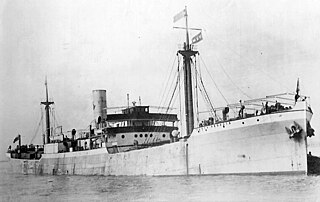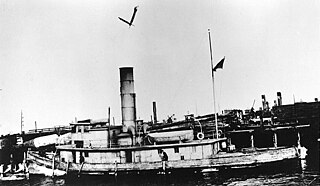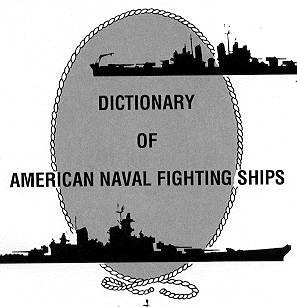 SS Virginian prior to her U.S. Navy service. | |
| History | |
|---|---|
| Name: | USS Virginian |
| Namesake: | Previous name retained |
| Completed: | 1904 |
| Acquired: | Probably late 1917 |
| Commissioned: | Probably early 1918 |
| Struck: | 12 May 1919 |
| Fate: | Returned to owner 12 May 1919 |
| Notes: | Served as commercial tug SS Blue Bell [1] or SS Blue Belle [2] [3] and SS Virginian 1904-1917 and as SS Virginian from 1919 |
| General characteristics | |
| Type: | Cargo ship |
| Tonnage: | 179 register tons |
| Length: | 90 ft 0 in (27.43 m) |
| Beam: | 21 ft 0 in (6.40 m) |
| Draft: | 7 ft 9 in (2.36 m) (mean) |
| Propulsion: | Steam engine |
| Speed: | 8 knots |
| Complement: | 15 |
USS Virginian was a United States Navy tug in commission from 1918 to 1919.

The United States Navy (USN) is the naval warfare service branch of the United States Armed Forces and one of the seven uniformed services of the United States. It is the largest and most capable navy in the world and it has been estimated that in terms of tonnage of its active battle fleet alone, it is larger than the next 13 navies combined, which includes 11 U.S. allies or partner nations. with the highest combined battle fleet tonnage and the world's largest aircraft carrier fleet, with eleven in service, and two new carriers under construction. With 319,421 personnel on active duty and 99,616 in the Ready Reserve, the Navy is the third largest of the service branches. It has 282 deployable combat vessels and more than 3,700 operational aircraft as of March 2018, making it the second-largest air force in the world, after the United States Air Force.

A tugboat is a type of vessel that maneuvers other vessels by pushing or pulling them either by direct contact or by means of a tow line. Tugs typically move vessels that either are restricted in their ability to maneuver on their own, such as ships in a crowded harbor or a narrow canal, or those that cannot move by themselves, such as barges, disabled ships, log rafts, or oil platforms. Tugboats are powerful for their size and strongly built, and some are ocean-going. Some tugboats serve as icebreakers or salvage boats. Early tugboats had steam engines, but today most have diesel engines. Many tugboats have firefighting monitors, allowing them to assist in firefighting, especially in harbors.
Virginian was built as the commercial tug Blue Bell [1] or Blue Belle [2] [3] in 1904 at Camden, New Jersey. She subsequently was renamed SS Virginian. The U.S. Navy acquired her for World War I service from her owner, the Southern Transportation Company, at Philadelphia, Pennsylvania probably sometime in late 1917. The Navy apparently commissioned her sometime in early 1918 as USS Virginian.

Camden is a city and the county seat of Camden County, New Jersey, United States. Camden is located directly across the Delaware River from Philadelphia, Pennsylvania. At the 2010 U.S. Census, the city had a population of 77,344. Camden is the 12th most populous municipality in New Jersey. The city was incorporated on February 13, 1828. Camden has been the county seat of Camden County since the county was formed on March 13, 1844. The city derives its name from Charles Pratt, 1st Earl Camden. Camden is made up of over twenty different neighborhoods.

New Jersey is a state in the Mid-Atlantic and Northeastern regions of the United States. It is located on a peninsula, bordered on the north and east by the state of New York, particularly along the extent of the length of New York City on its western edge; on the east, southeast, and south by the Atlantic Ocean; on the west by the Delaware River and Pennsylvania; and on the southwest by the Delaware Bay and Delaware. New Jersey is the fourth-smallest state by area but the 11th-most populous, with 9 million residents as of 2017, and the most densely populated of the 50 U.S. states; its biggest city is Newark. New Jersey lies completely within the combined statistical areas of New York City and Philadelphia. New Jersey was the second-wealthiest U.S. state by median household income as of 2017.

World War I, also known as the First World War or the Great War, was a global war originating in Europe that lasted from 28 July 1914 to 11 November 1918. Contemporaneously described as "the war to end all wars", it led to the mobilisation of more than 70 million military personnel, including 60 million Europeans, making it one of the largest wars in history. It is also one of the deadliest conflicts in history, with an estimated nine million combatants and seven million civilian deaths as a direct result of the war, while resulting genocides and the 1918 influenza pandemic caused another 50 to 100 million deaths worldwide.
Virginian served as a tug in the 5th Naval District—probably at Norfolk, Virginia, through the end of World War I and into the early months of 1919.

Norfolk is an independent city in the Commonwealth of Virginia in the United States. At the 2010 census, the population was 242,803; in 2017, the population was estimated to be 244,703 making it the second-most populous city in Virginia after neighboring Virginia Beach.

Virginia, officially the Commonwealth of Virginia, is a state in the Southeastern and Mid-Atlantic regions of the United States located between the Atlantic Coast and the Appalachian Mountains. Virginia is nicknamed the "Old Dominion" due to its status as the first English colonial possession established in mainland North America and "Mother of Presidents" because eight U.S. presidents were born there, more than any other state. The geography and climate of the Commonwealth are shaped by the Blue Ridge Mountains and the Chesapeake Bay, which provide habitat for much of its flora and fauna. The capital of the Commonwealth is Richmond; Virginia Beach is the most populous city, and Fairfax County is the most populous political subdivision. The Commonwealth's estimated population as of 2018 is over 8.5 million.
On 12 May 1919, Virginian was returned to the Southern Transportation Company and her name was stricken from the Navy List.
A Navy List or Naval Register is an official list of naval officers, their ranks and seniority, the ships which they command or to which they are appointed, etc., that is published by the government or naval authorities of a country.
Unlike most commercial ships commissioned into U.S. Navy service during World War I, Virginian never received a naval registry Identification Number (Id. No.).
















